#niklas luhmann
Explore tagged Tumblr posts
Text

Rainald Goetz mit Niklas Luhmanns 'Das Recht der Gesellschaft'.
Rainald Goetz. Celebration. 90s Nacht Pop. 1999, S.126-127
6 notes
·
View notes
Text
A good structure is something you can trust.
It relieves you from the burden of remembering and keeping track of everything. If you can trust the system, you can let go of the attempt to hold everything together in your head and you can start focusing on what is important: The content, the argument and the ideas. By breaking down the amorphous task of “writing a paper” into small and clearly separated tasks, you can focus on one thing at a time, complete each in one go and move on to the next one . A good structure enables flow, the state in which you get so completely immersed in your work that you lose track of time and can just keep on going as the work becomes effortless (Csikszentmihalyi, 1975). Something like that does not happen by chance.
- How to Take Smart Notes (Sönke Ahrens)
#Zettelkasten#Smart Notes#Slip-box#Niklas Luhmann#Knowledge Management#Active Recall#Linking Notes#Productivity#Creativity#Learning Strategies#Writing Papers#Academic Writing#Idea Development#Research Organization#Argument Structure#Evidence Collection#Drafting#Revision Techniques#Thesis Statement#Writing Process#Topic Exploration#Note-Taking Techniques#Atomic Notes#Contextual Notes#Evergreen Notes#Permanent Notes#Fleeting Notes#Literature Notes#Note Connection#Note Hierarchy
4 notes
·
View notes
Text
I think there would ba a place for Large Language Models in academic writing. Because the text is not the end, it is the means by which to make an argument accessible to the public. The production of academic text often works like this (in an idealized form):
You research.
You develop your argument.
You outline how to present the argument in the text.
You write the text.
You proofread and adjust the text.
If ChatGPT was capable of doing Step 4 well, there is no reason why it shouldn't be used. Especially because some people who have brilliant ideas are bad at communicating them, making it torturous for me to read their works. Maybe I would have had less trouble with Luhmann's systems theory if he had let an AI write his texts. (Like, he is really interesting, but I am doubtful I will ever bring myself to read one of his full length monographs.)
#large language model#chat gpt#ai#academic writing#writing#niklas luhmann#is the goal of this post to add something to the ai discussion or to drag luhmann?#i honestly don't know
4 notes
·
View notes
Text

„Alles Recht kommt in und durch Rechtskommunikation zustande.“
„Die Wirklichkeit ist das, was das System als Wirklichkeit herstellt.“
Thomas Vesting, Recht als autopoietisches System, S. 43 in
Lars Viellechner [Hrsg.] Verfassung ohne Staat
Gunther Teubners Verständnis von Recht und Gesellschaft

2 notes
·
View notes
Text

Cards I have yet to install in my Zettlekasten
#zettlekasten#analog#old school#note cards#index cards#handwriting#knowledge#information#aesthetic notes#reading#bookish#books and literature#note taking#bookstagram#antinet#niklas luhmann#quotes#second brain
15 notes
·
View notes
Text
"The Enlightenment idea was that social progress leads to more and more self-control. It enhances agency, rationality, and 'sovereignty.' That's the modernist dream. But systems theory suggests, quite to the contrary: The more society evolves, the more complex it becomes, and the less control is possible. But, no worries, the good news is: If there is less control, you're also less being controlled. In hyper-complex postmodernity we are out of control. This is the biggest difference between social systems theory and mainstream social and political theories. Most of these theories, in academia and media alike, celebrate the 'sovereign individual.' Both Jordan Peterson on the right, and social justice theories on the left do this as well. Luhmann labels himself not just a 'radical constructivist', but also a 'radical antihumanist.' This sounds terribly negative and pessimistic. And it probably prevented Luhmann's theory from becoming popular in North America, with its insistence on individual human agency and free will. However, Luhmann is not a pessimist at all. Just as there is nothing wrong with biological evolution, there's nothing wrong with an autopoietic society out of human control either. That humans are not ultimately in charge doesn't for instance mean that things cannot get better. Things can and do get better, but only in each respective system."
— Hans-Georg Moeller, Niklas Luhmann: A Super Theory of Society (2023) 25:39
"As capitalism concentrates wealth and power in ever smaller sections of society, university professors, media figures, lawyers, charity workers, community activists and officers in non-government organizations face increasing competition, falling incomes and dwindling status. Elites have been produced in numbers greater than society can absorb. If Western capitalism creates an expanding underclass without any productive function, it also produces a lumpen intelligentsia that is economically superfluous."
— John N. Gray, The New Leviathans: Thoughts After Liberalism (2023)
"capitalism is very difficult to define, having originated not as an economic concept but as a pejorative term first used by nineteenth-century leftists to condemn wealth and privilege."
— Rodney Stark, Bearing False Witness: Debunking Centuries of Anti-Catholic History (2016)
"Everything that could move a heart of stone was exhibited to my tranquil gaze; it got them nowhere, steadfast I remained: weeping mothers, naked infants, ghostlike figures wasted by hunger, I simply smiled, shook my head, and throughout those trying months slept as soundly as ever before and ate with an increased appetite. Taking stock of my sensations, I discovered that what I was feeling bore out my teachers’ predictions perfectly: instead of a disagreeable sentiment of pity, there was kindled in me a certain restlessness, a commotion produced by the evil I fancied I was doing in turning those wretches away empty-handed, and within my nerves there was a certain rush of heat much like the blaze ignited in us whenever we violate a law or subdue a prejudice."
— Juliette in Marquis de Sade's Juliette (1797–1801)
2 notes
·
View notes
Text

Formen
Wir gehen im folgenden davon aus, dass Formen zügig und/ oder gezogen sind. Sie sind zügig/ gezogen und bilden als Form auch ein Trajekt. Sie haben Falten. Dass sie Falten haben, heißt auch, dass diesen Formen involviert ist, was sie hinter sich gelassen haben oder ausschließen sollen. In gewisser Hinsicht sind sie diplomatisch und tragen Entferntes mit. Die Grenzen der Form gehen mitten durch die Form, durch die Form kommt die Grenze vor; diese Grenzen sind Kreuzungen oder Versäumungen. Die Form sondert das Informelle nicht aus, ist vom Informellen nicht ausgesondert. Jenseits der Form findet man andere Formen. In der Form geht die Form nicht auf: sie kann von ihrer Negation und von ihrem Anderen durchzogen sein. Zügige und faltige Formen sind keine reinen Formen, das sind Formen, die in ihrer Präsenz und Gegenwart nicht aufgehen. Ihnen hängt etwas an, sie haben mehr als nur sich und sind mit sich nicht eins. Diese Formen sind keine ersten und keine letzten Dinge. Den Begriff der Fiktion und denjenigen der Vorstellung assoziieren wir eng mit dem Begriff zügiger, gefalteter Form. Dass Formen Einheiten bilden, das behaupten wir nicht. Wir behaupten, dass dasjenige, was wahrgenommen und/ oder kommuniziert wird Form ist.
Für die Rechtstheorie heißt das, das wir das positive Recht nicht mit der Form und den Rest der Normativität mit informeller Kultur oder informellen Institutionen identifizieren. Wo eine Norm ist, da ist eine Form. An jeder Passage oder Stelle, an der oder durch die Differenz operationalisiert wurde, da ist eine Norm und da ist eine Form. Die Beispiele für Formen, an die wir denken, entstammen der Mediengeschichte. Es gibt zwei ideale Beispiele: Letter und das Tafelbild (Tabula picta). Diese Beispiele dienen uns, weil sowohl Letter als auch Tafelbilder in ihrer Form entzweit bleiben, darum über zwei Schichten weiter beschrieben werden.
Die Reproduktion von Formen, von der Luhmann spricht, assoziieren wir mit einer Geschichte und Theorie des Nachlebens der Antike, das heißt gleichzeitig: mit einer Vorstellung von Archäologie, nach der der Mensch von Natur aus ein phantasiebegabtes und 'aufsitzendes' Wesen ist, das mit Illusionen eine ungewisse Zukunft hat, bis es stirbt. Dieses Wesen lebt in gewisser Hinsicht asymptomatisch, lebt zum Tode hin so, als ob es überleben würde. Wo dieses Wesen aufsitzt, da sitzt es den Formen auf, die wir u.a. für zügig/ gezogen und faltig halten. Es mag Formen geben, die beides nicht sind, die also nicht auch Zug sind oder Züge haben, die keine Falten haben und deren Grenzen damit nur eindeutig sind, sondern Grenzen sich auch nirgends wiederholen. In Bezug auf Wahrnehmung und Kommunikation gehen wir davon aus, dass man eine Form wahrnimmt - unter Wahrnehmung einer anderen Form und unter Wahrnehmung von etwas anderem als Form. Man kommuniziert Form - mit anderer Form und mit anderem als Form.
Es kursiert in Deutschland die These, mit der Form der Schrift und im Objekt des gedruckten Buches habe eine Umstellung von Bildern auf Begriffe stattgefunden. Das wird für die Religion und sogar für das Recht behauptet, in der Kombination aus religiöser und rechtlicher Vorstellung lässt sich schon erahnen, dass so etwas von Staatsrechtslehrern behauptet wird. Wir gehen von Verhältnissen aus, wo das Vethältnis zwischen Bild und Begriff als Ablösung nicht der Fall ist, wo aber Formen eingeführt werden, die auf Schrift und Buchdruck so blicken lassen, als ob sie Mündlichkeit und Bildlichkeit jeweils als ein Anderes hinter sich gelassen hätten. Die Form der Schrift kann Mündlichkeit und Bildlichkeit auf eine Rückseite schlagen, der Buchdruck kann als Form und als Medium Formen und Medien mittragen, die, obschon er sie mitträgt, dann andere Medien und Formen, sogar überwundene Medien und Formen seien sollen. So kann der Buchdruck das Dogma der großen Trennung tragen, wie etwa bei den Juristen, die behaupten, mit ihm habe gesellschaftlich eine Umstellung von Bildern auf Begriffe stattgefunden.
1 note
·
View note
Text

Is Camille Paglia’s “Decadence” a type of horror in modern society?
Her takedown of Kafka and the early Romantic poets starts with Wordsworth, who “wants nature without sex” and sparked a “movement in modern literature leading to . . . Kafka’s crippled cockroach”, a literary invention that “forfeits maleness for spiritual union with mother nature: wholeness through self-mutilation.” (pp. 300-301) I never thought of Kafka as a metaphorical eunuch, but then again Paglia makes the same charge of James Joyce, whom she lumps together with Henry James, “a eunuch-priest of the mother goddess.” (p. 49) Paglia traces this line of emasculated malcontents back to Rousseau and his ideas such as the ‘noble savage’. To large degree I agree with her about Rousseau, who I’ve read also inspired Pol Pot. However, sometimes I find her ideas about maleness a bit trifling, almost like her entire argument rests on a straw man (haha pun intended). Certainly most writers don’t live normal lives any more than serial killers do. It strikes me as paradoxical that Paglia would like to describe poetry and art in terms of sexual virility, yet she would have us believe that mother nature demands that her priests be castrated. Still it occurs to me I have misunderstood Paglia. She is essentially a real pagan, insofar as any materialist can worship anything, and insofar as paganism exists in modern society through ripples in the art subsystem, popular ‘new age’ movements, and even via remnants in Catholicism. G. K. Chesterton made a similar point about Catholicism being most of what’s left of paganism, which I would say includes folklore. Modern folklore would include cinema and other forms of pop culture.
It seems to me though, that Paglia would love to travel back to the time when art lived in “magic circles . . . sacred spaces . . . [and] sexualized spasms of creation”. (p. 328) She posits a rear guard action of premodern paganism against modern society, a “war between vision and language”, (p. 339) waged across an enchanted battlefield haunted by the godlike forms of Apollo and Dionysus, the spirits of Nefertiti and Emily Dickinson, all bound in ritual service to the demigods and demigoddesses of ‘Iconos’, Hollywood, and perhaps even ancient mystery cults reborn as the castrati of ‘the deep State’. Then you take a breath and remember that art is just another differentiated subsystem of modern society, with no more weight than politics, law, science, religion, or even sports. The pagan cinema may rule the western eye, but the written word still controls the western courtroom and the electoral college. At least that’s what you tell yourself. Even Luhmann called out modern distinctions as “illusion” now and again. The written word ironically enough does appear to still govern scholarship, but Paglia argues that the written word too can be Dionysian. (discussing Wilde p. 562 and Whitman p. 604) Certainly the word appears necessary to explain the image. Even folklore must be spoken to survive in meaningful form. Some visual arts exist in folkloric crafts, sigils, signs and dance, but meaning remains confined to the word no matter how many Amish barn hexes are photographed. Cinema which can be visual storytelling is perhaps the best example she’s got of the image as meaning, but this book isn’t really about cinema, and besides, do all of these oicotypes on the screen actually support her argument or would she be forced to cherry pick?
Regardless, I would call her a boxer, a fighter, an Amazon as she might admit but most of all a terrorist in the sense that she is a terroristic thinker. For anyone who studies academic communication this should come as no surprise as academics are in the business of erasing modern distinctions as it suits them, so long as their own professional distinctions remain intact. The terroristic thinker like an actual terrorist seeks to destroy modern distinctions but with metaphorical bombs aka words. Paglia leads with a Molotov cocktail from Egypt, then a letter bomb from the Greek theater, and then she heads for the central bank of the humanities, aka poetry and literature, to read the entrails of her hostages.
She has definitely given us something to chew, a bloody piece of chthonian meat, but will the gorgons of ancient empires or even the silver screen turn us all to stone? Paglia does hint at this separation between art and life when she says “Greek tragedy is a conceptual cage in which Dionysus, founder of theater, is caught.” This has been said about horror movies too, well before this book was written even, by film critics also influenced by Freud, speaking in context of ‘the return of the repressed’, and Paglia largely agrees when she says that “[a] play is an anxiety-formation freezing . . . barbaric Protean energy.” (p. 101) It is easy to see the Bacchae as a horror or disaster movie. I am reminded of how prominently the Bacchae features in My Dinner with Andre, a film also about the battle between society and nature. Andre Gregory would likely agree with Euripides’s assessment of a society in its “late or decadent phase”. (p. 102) Dionysus, like the horror film boogeymen of our own age, represents “the return of the repressed, the id . . . bursting from bondage.” (p. 103) Andre Gregory’s idea to use the actual head of a human cadaver in his production of the Bacchae seeks to sever the modern (‘decadent’?) distinctions between theater and life, performance and consummation, society and nature. Like terrorists both ancient and modern, Dionysus destroys distinctions and tears apart differentiation, or as Paglia says, “dissolves the Apollonian borderlines between objects and beings.” (p. 103)
Last I checked, military weapons also perform this function in modern society, both because of and irregardless of their ‘hard Apollonian edge’. This is another paradox that Pagalia does not approach directly, the idea that the hard modern edge actually destroys itself, as part of its autopoietic function, in order to allow space for ‘the individual’. As other commentators such as Matteo Pasquinel have argued in discussing the “uncanny . . . neurological traumas [of] the alien hand . . . first described by the German-Jewish neurologist Kurt Goldstein in 1908” (see Pasquinel’s article “The Alien Hand of the Technosphere. Kurt Goldstein and the Trauma of Intelligent Machines”, available at Academia.edu), trauma itself could be a part of society, a source of identity and even growth for the individuals caught up in society’s web. “The Bacchae [like Andre Gregory’s avant-garde pretensions] deconstructs western personality.” (p. 104)
Andre Gregory is surprised that his privately commissioned personal flag ends up including the Tibetan swastika; he is careful to stress its less sinister quality as “not the Nazi swastika . . . one of the most ancient Tibetan symbols”, yet he continually brings up his subtle connections (social and psychological) to Nazism. If you read his autobiography Gregory accuses his own father of having been a Nazi collaborator. Furthermore, he mentions in the autobiography his avant-garde theater company had connections to the CIA among its board members. The hydra of MK Ultra and its attendant conspiracy tales rears its many heads, a modern gorgon that has given form to American conspiracy folklore since the sixties. The paradox is also a distinction, order/chaos, and order thus also includes chaos or the Dionysian power to disorder someone’s mind. Disinformation or counterintelligence is specifically relevant, but always must contain some truth to do its work.
In context of the academic coding ‘true/false’, Paglia’s book then to me appears something of a tangled mess but perhaps it is meant to be. Paglia draws lines such as between distinctions like ‘image/word’, and then scribbles over them hastily in places, revising her theory as she goes. There are some inconsistencies here that serve her terroristic ends. Terror in its political sense, and horror in its theatrical, like tragedy I would agree with Paglia, “springs from the clash between Apollo and Dionysus” (p. 104) or one could say the conflict between order and disorder. The classical horror narrative always cycles through safety and security (order), to threat (disorder), and back to order again. (see Monsters and Mad Scientists by Andrew Tudor) Andre Gregory and his pet avant-garde (again perhaps so delicately shepherded by the CIA in both its board connections and top secret LSD experiments) would like to let Dionysus out of his cage, even if still keeping the (lower case) god on a leash. Niklas Luhmann’s riposte to all of this is that order/disorder still functions to maintain society, its autopoietic ebb and flow like nature itself, now beyond the ability of individuals to control. “Individualism and self-realization as a model” (p. 10) may easily become decadence, is what Paglia suggests and even celebrates, but without order there can be no decay. A living system or ‘nature’ has its own order that perhaps the acolytes of Dionysus are too blind to fully describe. Though Paglia never mentions him, I would say that as Jack Kerouac pointed out (more or less), decay is a part of the life of human systems like cities, society, or empire.
Paglia favors pagan empires over Christian ones, and prefers “ritual orgy” to “street carnival”. (p. 138) Her idea here could be only that ‘ritual’ is more honest than ‘carnival’. “Religion, ritual, and art began as one,” (pp. 28-29) but of late our society is differentiated as Niklas Luhmann points out. ‘Invisible hierarchies’ may be constructed to replace the premodern ‘visible’ hierarchies of the ancient world, Paglia is telling us, and with that I think Luhmann would agree. “Freedom makes new prisons.” (p. 235) Apparently modern society can repress the pagan rituals only so much as they will always resurface in the dreams and fantasies of society, aka cinema and folklore. However in a differentiated society is this such a big deal?
Just rewatching the classic 80s action flick Highlander which has a brilliant fade out from the hero’s face to a mural of the Mona Lisa on the side of a skyscraper in New York City. Paglia calls the Mona Lisa a kind of totem in the art world, “the premiere sexual persona of western art”,(p. 154) which functions as “an apotropaion, a charm to ward off evil spirits, like the giant eye painted on the prows of ancient ships. (p. 49) The Mona Lisa to Paglia presides “over her desolate landscape . . . a gorgoneion, staring hierarchic of pitiless nature.” (p. 49) The immortal catch phrase from Highlander of ‘there can be only one!’ might as well be the battle cry of every sperm on its way to the egg. The immortals here seek to decapitate all the other contenders. Alan Dundes the folklorist points out that decapitation is a substitute in stories for the motif of castration. This story then softens the harsh realities of nature for a wider audience perhaps. The story told in the film is of the efforts of an immortal few to civilize the barbarism of earlier ages. The crude and premodern Highlander calls the civilized Ramirez a “Spanish peacock”, to which Ramirez replies that he’s originally Egyptian, a detail I find intriguing in reflection of Paglia’s argument. Vampires too in the popular imagination can always be traced back to Egypt (see Anne Rice, The Hunger, etc.), and the immortals in Highlander are also compared to vampires. Also the bit about “holy ground” which is a traditional no-conflict zone that none of the immortals will violate, even the evil, barbaric antagonist, the Kurgan. I’m sure Paglia would make much of the scene where the Kurgan jokingly says “Mom” in mock affection to his carjacking victim. Yet this bit of folklore cannot escape a moral view. One can say it is merely ‘quasi-Christian’, a global universalism perhaps, with Churches still considered holy and assuming as it does a super nature without speculating much about the origins of this “kind of magic”. The “prize” here is a single unifying mind to guide humanity (a kind of monotheism?!). The failure of the heroic Highlander to secure this ‘treasure’ would be to leave this power in the hands of the Kurgan, an evil (Dionysian) force opposed to all decent, reasonable and humanitarian ends, i.e. antisocial in every sense, and with this I think Paglia would agree, that society creates these distinctions to protect the weak.
However, Paglia’s idea is that these good intentions are illusory, or at least ‘on the road’ to somewhere entirely unintended. Always underneath the good intentions of society, there is a destructive darkness, she would say. As a social systems theorist might say, there is no perfect system. “Every road from Rousseau leads to Sade” is Paglia’s Nietzschean gauntlet cast down at the feet of modern pieties. (p. 14) She points out correctly that in movies we can also see this in the example of “the femme fatale [who] reappears, as a return of the repressed”. (p. 13) In communication one can only observe what is not discussed as an ‘unmarked space’ according to Luhmann, and Paglia makes a similar observation when she says “what is not said presses upon what is.” (pp. 615-16) So each communication one could say ‘represses’ that which it does not discuss, an inevitable result of the reduction in complexity necessary for communication to occur. (This is perhaps one reason why autopoietic communication may never stop—there is always something left out of the previous system operation.) I’m surprised that so far Paglia doesn’t address directly the possibility that horror movies are a modern version of Sade. Of course she mentions pornography, but reading her descriptions and quotations from Sade, I was struck forcefully with the connection between Sade’s writings and body horror. Sade was perhaps an aristocratic version of Ed Gein, at least on paper. Too bad Tobe Hooper never made a movie about the French Revolution. Again, I had to repeatedly remind myself that despite the bombastic and nearly apocalyptic tone of this book, it is mostly about the art subsystem.
I suppose after awhile it appears to me this is also about a moment in our own contemporary history, the rise of gay rights, feminism, and the impact on our society of these movements. Paglia is a defender of “Decadence”, which she equates with “aestheticism”, (p. 512) and ultimately she connects these concepts to the creativity of both modern (differentiated) society and specifically the art subsystem. Paglia apparently has no concept directly equivalent to system differentiation and I would say she goes too far when she claims that “Romanticism freed art from society and Christianity”. (p. 513) So for Paglia, writing within the academic subsystem, she would describe the differentiated subsystem of art as “freed”. It makes sense to me that an academic would say that, but is it accurate? Certainly modern society has a place to stash its decadence, and no erstwhile Oscar Wildes will be thrown in gaol (aside from perhaps in a few extreme national segments within the global order that still entertain such a possibility). At least many artists continue to believe in the heresy that ordinary rules of society do not apply to them. A true Romantic might argue that Oscar Wilde’s power derives paradoxically and in some small part from his persecution. Niklas Luhmann argues that segmentation (such as into different national jurisdictions in the legal system) can facilitate global social system evolution by increasing variety and I would think the same holds true for differentiation. So Paglia’s case perhaps is a bit overstated or even hyperbolic. I won’t go so far as to call it ‘hysterical’, as that is out of fashion.
However, she does correctly diagnose the difficulty with all human systems of communication, which is the ultimate ‘tenemos’ (sacred or unobservable space)—consciousness. In rather spectacular fashion she gets at the root of all social system ‘problems’ which is to map the mind or personality. ‘As above, so below,’ as they say. Now humans are really attempting to build artificial brains that may outperform our own! Paglia correctly points out that older systems, social ‘maps’, or ‘models’ were essentially about the same problem, even if based in less than scientific methods. The “predictive part of astrology is less important than its psychology.” (p. 222) Setting aside for the moment the idea that nearly all of civilization can be traced back to writing and the theory that writing is founded in the practice of divination (prediction!), we are back to the ‘New Age’ and older ‘magical’ systems as ‘self-help’. (see Freemasonry for example) A dash of Jung’s “synchronicity” (p. 222) and the idea that the “Greek word zodiac means circle of animals” (p. 222) and we can return again to folklore and its animal fables, along with the ultimate end game in the west of all this theatricality, the hardest edge of all as far as personality goes, the sociopath, psychopath, antisocial or ‘predatory personality’.
The Zodiac killer perhaps not interested in scholarship but only in codes, even social codes or conventions, the cypher of the identity of ‘the individual’ as the ultimate secret, unobservable by even the most determined Quixote or tradecraft specialist (aka the classic ‘fool/detective’ or even ‘writer’). The text becomes a dream/nightmare for only a moment before we wake up to discover we have never left the art subsystem entirely. “Things happen in complex patterns of apparent coincidence, noticed by the keen eyes of the artist.” (p. 222) David Fincher (or George Smiley) couldn’t have said it any better. Paglia delves into what one might call the ‘philosophy of serial murder’, which she describes as “a perversion of male intellect. . . . There is no female Mozart because there is no female Jack the Ripper.” (p. 247) Funny I find out later this is one of her most quoted lines. The folklore around serial killers is thick. However, Paglia’s high end taste has no room for “horror films . . . of the splattering kind” which she finds “pedestrian.” (p. 268) Nonetheless she argues “[h]orror films are rituals of pagan worship.” (p. 268) I would say they entertain modern audiences by allowing social description of a collapse of differentiation within the ‘cage of theatricality’, i.e. at a safe distance. Serial killers such as Edmund Kemper may claim to collect their victims as ‘spirit wives’, and the Zodiac claims to collect the souls of his victims as ‘slaves’, but no matter how much art goes into a work directed by David Fincher, like the “run-of-the-mill horror film” such killers remain “anti-aesthetic and anti-idealizing”, expressing “the form-pulverizing energies of Dionysus.” (p. 268) Yet no one who is not a specialist can recall the names of Kemper’s victims, or the Zodiac’s for that matter. They remain ‘slaves’ at least in a social sense, to serve their murderers in a social afterlife if not metaphysical, a true decadent ‘dead end’, as Paglia might admit.
Paglia sometimes fights against her own pessimism it seems though, arguing that “great literature and art [even if] never affirmative”, may still be celebrated “in order to win victory over something else, something uncontrolled.” (p. 383) So perhaps her end is control, steering. Luhmann says you can’t steer society, but he agreed that ‘problems’ are the ‘catalyst’ of social system function. I recall at this time Paglia’s discussion of Elvis, whom she calls “a myth-maker”, and when my wife and I visited Graceland, I pointed out a book (that belonged to and may even have been read by Elvis) in a glass case about ‘the Age of Aquarius’ opened to a page that had text underlined about how this age would be characterized by an empowerment of women. Oddly enough while raking leaves on a Saturday, the thought occurs to me how powerful Christ remains, despite his critics and the differentiation of modern systems of communication on display here. The words Paglia uses ultimately come across to me as defensive, a charge she often seems to level at the Romantic poets she studies. It strikes me that she feels compelled to compare all of this analysis against the example of Christ, even if she gets it mostly wrong. Her understanding of Christian doctrine on Gnosticism I would suggest is woefully lacking, to cite one example. All these petty magicians and artists, along with the bomb throwers accompanying them, cannot compete with the truth of Christ, no matter how many armies of academics hue and cry that modern society has been “freed” from the Holy Roman Empire. (see Radiohead for example) Religion remains as important as art for understanding society, precisely because so many seem compelled to attack it. With a description of the “social ostracism” of lesbianism as “heroic”, according to Walter Benjamin no less, even Baudeaire writes from a “world-view [that] is Christian” according to Paglia. (p. 426) To quote Gang of Four, “no escape from society.”
Paglia approaches this idea when she admits Oscar Wilde’s “glittering great chain of being is . . . not the actual world of law, finance, or aristocracy.” (p. 567) One could add ‘or religion’, but like Wilde, I would say Paglia remains trapped within her own academic “visionary construction” close to what some call ‘the genital chakra’. Such illusions of spirit or theory appear as a (false) method of escape (transcendence), to join with the too-serious scholars of Tao, other types of intellectuals, serial killers or similar ‘statistical unpersons’ desperate to communicate but unwilling to compromise a singular vision of either self or society. All of this ‘decadence’ may be not much more than the fracturing of identity under the weight of the differentiation of subsystems in modern society such as art, religion, economy and politics. I recall some studies show schizophrenia increases in many urban areas. Paglia herself points out scholarship indicating “the nineteenth century self came apart or ‘pluralized’” (citing Van den Berg, p. 493) As Luhmann points out in his treatise on the religious subsystem, the shaman does not always return from the trance journey aka ‘vision quest’. Poets too carry this risk. Any seeker of associative knowledge may become trapped in phantasms of dissociative agony, especially in a fragmented/differentiated society so keen to uphold individuality/trauma as a model of self actualization. If the shaman or the poet runs the risk of merely trading one form of trauma for another, then one can see this mirrored in the complexity and differentiation of modern society. Mother nature as much as man it seems is looking for the hard Apollonian edge of a rocket to carry her children off world. What could be more natural than to reproduce life on another planet? Conflict, both sexual and social, may be as much required as stability in order to self-generate these systems, whether psychic (individual) or social.
Still Paglia hardly touches the gleeman poets, mostly keeping to the scholar poets (or those with sufficient wall of scholarship around them to guarantee a labyrinth). She scratches the surface of Elvis yes, briefly comparing him to Byron, but fails to remark on the long-standing feud between the scholar poets and the gleemen poets (or minstrels as they say). I’m not sure if the gleemen side would entirely support her thesis but she seems determined to add “the King” into her mix. Elvis though obviously a sexual icon is only barely androgynous. He owned a .45 with a turquoise handle initialed ‘E’ on one side and ‘P’ on the other. Fairly masculine I’d call that. Then again William S. Burroughs was fond of shotguns too. I think the Beat poets as I mentioned Kerouac above might also throw a few solid punches at Paglia’s thesis. I base this on watching the documentary about Kerouac where Gregory Corso said it best: “Spirit is a hard, tough baby.” Is Kerouac too a deformed priest of the mother goddess, or was he beaten down by Madison Avenue usurping and twisting his message? I suppose he did have some issues with his mother, who was also a drunk. I wonder where does Johnny Cash fit into her scheme? He walks the line yes, but that ring of fire is suspect. Or Bob Dylan? The resolution of the thousand year feud between the scholar poets and the gleemen finds this Nobel Prize winner calling for a truce! He just wants to be friends with mother nature one could say, and doesn’t want to get pulled down in a hole by those who are deformed by “society’s pliers”. (Paglia does finally get around to mentioning Bob Dylan, though she indicates he isn’t upset enough with Christianity for her tastes or Emily Dickinson’s haha.) Even the likes of Tom Petty might have a line or two about this ‘American girl’, but perhaps nothing that would satisfy Paglia, who nonetheless claims “[w]e still live in the age of Romanticism.” (p. 358) To my line of thought it is another example of a certain type of scholarly hyperbole when she calls Edie Sedgwick an “androgyne” who most men would say remains precisely female regardless of her haircut.
Ridiculous also when Paglia agrees with Bloom that Robert Graves is wrong about Keats and “his White Goddess”. (p. 385) Paglia has a real problem it seems with Graves whom she calls homophobic (p. 672), a decadent slur if ever there was one. As in her analysis related to Christianity, I detect some defensiveness on her part. Graves’s analysis more than any other agrees with her position on Wilde who in “trying to remove the chthonianism from nature, trivializes her, an error for which he will . . . suffer.” (p. 565) I’ve heard some folklore that editors who turned down Graves’s book The White Goddess suffered too. From Paglia’s perspective, Graves perhaps trivializes homosexuality or androgyny in relation to his ‘White Goddess’. The charge may be accurate but is Graves actually more correct in his reading of the relationship between poet and muse? My own reading of Graves suggests his analysis is more deeply connected to the poetic. Graves would never say the White Goddess demands castration of true poets, admitting though that seeking this prize may lead to madness or death. Graves also offers escape from Paglia’s ‘cult of self’ when he suggests that self-knowledge can be properly left in the care of a wife or mistress. I should note that Graves addresses Paglia’s concerns even more directly when he says that the real sin of Socrates was not homosexuality, but only the idea he could know himself “in the Apollonian style”. (see The White Goddess, p. 12)
Perhaps the problem here is that Paglia is merely a critic, and no poet so far as I know. She relies on the “principle that the western objet d’art is an Apollonian protest against the chthonian.” (p. 388) Yet the range of human emotion and personality, one might argue at least, transcends the sexual. She screams that the “eye” of decadent late phase art “becomes its own prison.” (p. 419) (Yet I searched for any reference to Georges Bataille but nothing in the index haha). She does get around to mentioning surrealism, but in the context of Dickinson’s ‘surreal’ poetry. I would maintain (and I think Niklas Luhmann’s social systems theory supports me in this) that the eye is only perception and not all encompassing of society (communication) or personality (consciousness). Paglia finds the opposite to be true, namely that if “psychic . . . therefore sexual”. (p. 436) I would argue that this central assumption of her analysis rings false. For Paglia “sexuality, even at its most perverse, is implicitly religious.” Certainly this concept is blasphemous even for academia, which allows for study (observation) of sexuality as a purely biological function. One might as well say that physics is implicitly religious, certainly a collapse of differentiation. In accepting only a material interpretation of reality then, religion is only a connection to nature, a pagan concept for Paglia, and essentially premodern. “Sex is the ritual link between man and nature” is her claim, (p. 436) but is it the only such connection? In removing any possibility of ‘super nature’, Paglia essentially removes the connection between man and God, something which can exist both inside and outside of nature. Perhaps then her idea of decadence as “abandonment of . . . duty” (p. 437) at least is consistent with something (“duty”) which can be described as transcendent. Paglia rejects duty in favor of androgyny, but her idea about androgyny is a false idol.
After reading this book, I’ve never been so sick of the word “androgyne” in all my life. Perhaps it is because my father is a narcissist. The “androgyne” (like the narcissist) is the perfect monster, a “[s]elf-complete” being that needs “no one and nothing.” (p. 441) When I was a teenager for a few weeks one summer I became half-convinced my father was planning to murder us (the whole family) with a shotgun. I say ‘half-convinced’ in that I almost believed it, and even took some actions to disrupt his possible plans, like hiding his shotgun shells for a week or so, before I suddenly put them back, nervously thinking I would be discovered, and telling myself I was being foolish, that my father wasn’t really planning on murdering us all, that it was only a strange notion in my head. I now see this anxiety as my conscious mind struggling with what my intuition (my ‘unconscious’) already knew, that the family was merely an accessory to my father’s monstrous ego. He could discard us at any time, as it suited him. So long as we served his purpose of perhaps securing his own position in society as ‘the breadwinner’ and ‘family man’, he would keep us around, but if we ever got in the way of his desires, he could cut us out of his life as easily as he cut out cancerous lungs from his patients. Years later, sitting out on a deck at Chimney Rock, my mother tells me that it has emerged through their marriage counseling sessions that my father is a narcissist. This all came out into the open due to a ‘blackmail attempt’ caused by my father’s ending of a long 20-year affair (that she knows of only because he had been forced to confess after the attempted blackmail). I would later connect all these dots to my anxiety that one summer from my youth.
This is one thread that goes through my mind reading Paglia, a little personal experience of decadence that contributed to my own fairly unsuccessful sojourn in the art subsystem during the 90s. By the time she gets to Swinburne, the journey through the narcissistic prison of the genital chakra has worn me out. “Decadence is about dead ends.” (p. 494) Is Paglia’s criticism itself decadent, a dead end? Oscar Wilde is close to the coup de grace. His “one liners . . . [owe] something to ‘the Irish—perhaps originally the theological—habit of paradox.’” (quoting Brigid Brophy, p. 545) In the old world I recall, the only one who could criticize the king was the court jester. Comedy in English, Paglia explains, depends on the conflict between order and disorder, aka “the context of British formality.” (p. 550) This connection between slapstick and zombie films is brought more fully into the light—perhaps the reason for the pie fight sequence in George Romero’s Dawn of the Dead (1978). The zombie, like the ‘androgyne’ or narcissist, is self-sufficient (aside from a hint of cannibalism). Comedy and tragedy united in horror, together at last, “darting into the linguistic infinite on a jet of the English epicene.” (p. 550) Finally I feel quite dumb, a middle manager, not at all qualified to hang out with these sophisticates in their “matrix of perverse fantasy”. (p. 371)
She wants to somehow be able to cast certain decadents, or libertines, as defenders of civilization, as “Apollonian”. So to believe this line of thought, one must accept that “[f]or the idealizing Wilde, the chthonian is literally an alien realm”, and he desires somehow “to keep his native tongue in a state of Apollonian purity.” (p. 562) Isn’t the word always Apollonian at its root? Again as I’ve already pointed out, Paglia suggests it can also be Dionysian in the case of Wilde and Whitman. (pp. 562, 604) However by the terms of Paglia’s own argument, decadence can never be entirely Apollonian but always essentially Dionysian, as it creates chaos in the social order through abandonment of duty, a line that could be said to define modern society at the most basic level within every subsystem. For example in the law of tort we find its standard of care which all people in society owe to one another. In religion they call this ‘the golden rule’. Does the academic subsystem have its own version of this? Certainly tenure and other social structures such as rules against plagiarism could be seen as rigidly hierarchic and imposing of duty. Art in modern society of course faces a precarious position with its coding of ‘art/non-art’—those like Wilde who would like to live through their art, risk violating the only moral rule that does apply to the art system, namely that anything outside (‘non-art’), anything which steps beyond the ‘conceptual cage of theatricality’ reserved for the Apollonian/Dionysian battle in our society, no longer receives the same special dispensation generally granted to the genius to act outside the rules so to speak, as the village idiot, jester, fool, madman, or visionary he or she may claim to be. Artists like to play with this edge I agree.
As for Paglia’s claims, despite the brilliance of this book, I’d say she is hyperbolic and sometimes clearly false. “Mythologically”, she claims, “there never has been a purely masculine vegetation deity.” (p. 588) Osiris? Yes in the myth cycle he is castrated and then reborn, but clearly masculine and so she’s off base about this claim. I wonder though if any man is ‘purely masculine’ enough for Paglia? Any man that shows tenderness is ‘homoerotic’ it seems, there is no such thing as a comrade in arms or a friendship, and any verse or man who is too masculine is repressing something—there is no escape from her labyrinth, her analysis has no doors or windows for the light to enter this oubliette, no opening in her vision for transcendence through the “umbilical noose” as Kurt Cobain called it. Trauma it would seem is a part of life, for both men and women, but does all art have to be erotic? Paglia's analysis is suddenly reminding me of that film by David Cronenberg, They Came From Within. Everything becomes sexual for Paglia. Anything “light and frothy” is actually “perverse psychodrama”. (p. 642) When the poet says “I had rather be loved than to be called a king in earth” this cannot be the simple cry of loneliness expressed by an emotional and physical shut-in, but must be “the option of a future sex change.” (pp. 640-41) Paglia accuses Melville of being “[w]hipsawed between paradoxes” but she ignores her own. (p. 589) I would say the biggest gap in her analysis is the New World, i.e. America, clearly a break in the ice of the ordinary decadent amusements of Europe, but she skates around these incongruities. For Paglia, Mark Twain is “completely out of sync with the internal development of major American literature.” (p. 623) She hates anything sincere or kind it seems, and imagines that writers and poets must follow her own theoretical time line and frame.
So I ask her, are poets not allowed to grow up? Is everything truly perverse or is that only her hope? Is there nothing outside this obsession with self? Has Paglia cherry-picked art that only supports her case? Perhaps all critics must do this to a degree but her choices sometimes break under close scrutiny. For example, she invokes traditional folklore in her analysis of Emily Dickinson when she argues “[t]he shoe is a male gift, not a prince’s glass slipper but a paternal tyrant’s iron boot.” (p. 645) Alan Dundes the folklore critic (another admirer of Freud) too describes the glass slipper or a shoe as metaphor for sex. Still I find Paglia’s analysis overwrought and avant garde, i.e. divorced from popular (‘folk’) meaning. Folklore and film critics make the same mistake when they call John Carpenter's Halloween ‘conservative’ in the political sense, ignoring the popular (and modern) thrill in watching social authority fail to stop the threat. For Emily Dickinson, a day at the beach, and the sea is a ‘he’? “His Silver Heel” fills up her shoe. (p. 645) Where is ‘mother nature’ in these words? How does this not express some degree of heterosexual desire? It has me thinking, could the ‘he’ be akin to Poseidon? Paglia does not comment on this pagan association but to me the line suggests another ‘nature divinity’ that is masculine and throws a wrench in her efforts to lay it all at the feet of mother nature. The unmarked space in this book is vast as the sea - so sweeping in its ambition, yet so narrow in its focus. I am reminded of Shakespeare: ‘the lady doth protest too much’. To return here to where we began, Paglia accuses James Joyce of writing a maze of words, lumping him together with Henry James as “a eunuch-priest of the mother goddess”. (p. 49) My thought here though (to borrow a phrase from childhood) is ‘takes one to know one’, i.e. that Paglia has also created a brilliant but “tangled reality of a labyrinthine construction . . . to entangle intruders”, (p. 49) a mess of a book as part of her own pagan worship of art amidst this “frigid, godless universe”. (p. 656) It drags at the end and feels masochistic to even finish it. I dare say I’ve had enough psychic vampirism in my own real life to want to read anymore about Emily Dickinson and this cult of necrophilia. How Paglia can find this to be invocation of the muse seems to privilege death over life, when love cannot exist without both sides of this distinction. Ultimately this tome reminds me more than anything of how C. S. Lewis described Narnia under the white witch, to paraphrase, ‘like winter without Christmas’. Finally though, what this odious quagmire of a book suggests more than truth is this unmarked space, that our merely human efforts to describe nature and even ourselves are forever incomplete.
1 note
·
View note
Text

Niklas Luhmann | Soziologische Aufklärung. Aufsätze zur Theorie sozialer Systeme | Band 1 (4. Auflage 1974)
Niklas Luhmann (December 8, 1927 – November 11, 1998). As the most important German-speaking representative of sociological systems theory and sociocybernetics, Luhmann's systems theory is one of the classics of 20th century sociology.
Cover-Art: Hanswerner Klein
0 notes
Text
Theoriebezüge in der systemischen Therapie
In einem sehr lesenswerten Beitrag, der als Open-Access-Artikel im Psychotherapie Forum erschienen ist, beschäftigt sich Elisabeth Wagner aus Wien mit der Relevanz systemtheoretischer Theorien für die klinische Praxis. Im Abstract heißt es: „Die enorme Binnendifferenzierung der Systemischen Therapie bietet zwar eine nützliche Vielfalt an Interventionsmöglichkeiten, führt auf der theoretischen…
0 notes
Text
Niklas Luhmann – Tutku Olarak Aşk (2023)
Eğer tarihsizmiş gibi görünüp doğallığın dokunulmazlığına itilen fenomenlerin tarihsel olarak oluştuğunu ve toplumsal olarak koşullandığını, dolayısıyla değişime açık olduğunu göstermek sosyal bilimin göz ardı edilemez meziyetlerinden biriyse, Niklas Luhmann ‘Tutku Olarak Aşk’ta aşkın modern tarihinin izini teorik inceliği ve empirik titizliği elden bırakmadan sürerek yirminci yüzyılın usta…
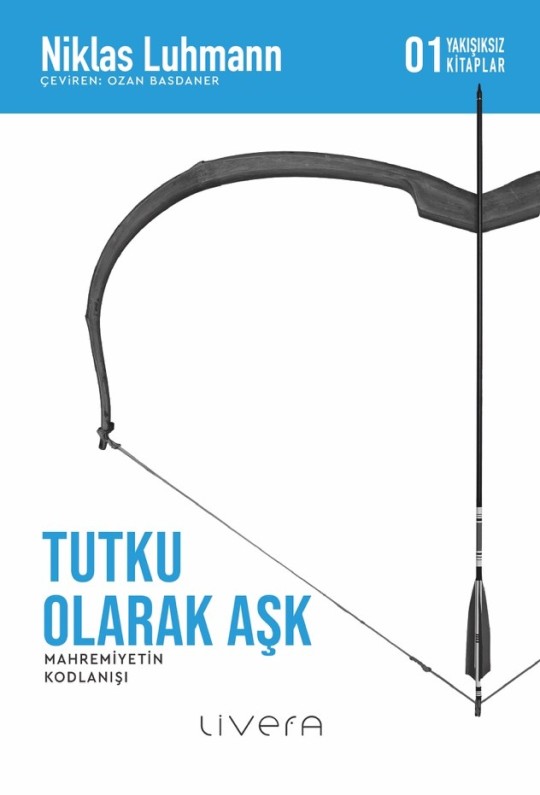
View On WordPress
0 notes
Text

The Systems Theory by Luhmann is just 🤌🏻
1 note
·
View note
Text
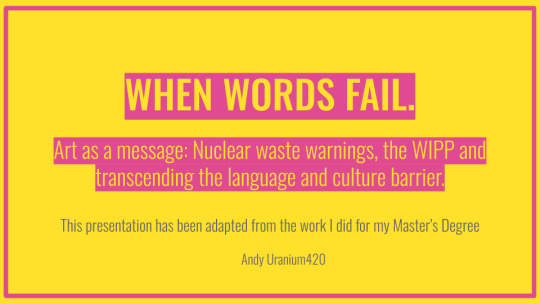
Hello! I wrote this symposium presentation for my master's degree in artistic practise in 2022 :) If you would like to cite this symposium please message me off-anon and I will give you the details needed :)
I considered adapting this presentation into essay format for tumblr, however that would be a massive effort, given that all my sources for this presentation are not formatted for the essay structure.
This is NOT a quick read, but I appreciate you even considering reading :) thank you!
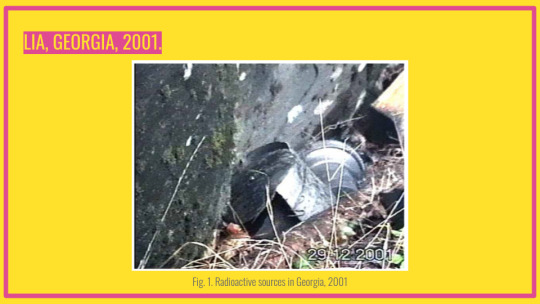
It’s 2nd December 2001, near the Enguri Dam, Georgia. Three men walk into a nearby forest, looking for firewood. The winter sun sets early so the men decide to spend the night in the forest and take the wood back to their trucks the next morning. Around 6pm they find two strange objects, cylindrical in shape, and 15 cm in length. The snow around these objects is melted, and the wet soil is steaming from the heat. One of the men picks up one of the objects, and drops it immediately, as it is too hot to hold. They decide to use the objects as personal heaters, while they sleep in the forest waiting for daylight. They begin to feel sick; so sick they don’t sleep, and spend all night vomiting. The next morning they only load half the firewood into their truck, they are exhausted.
It’s 22nd December 2001. All three men are admitted to hospital. On 23rd January 2002, one of the men is discharged from hospital. On 18th March 2003, a second man is discharged from hospital. On 13th May 2004, the third man dies, having never been well enough to leave.
What they found were radioactive sources of Strontium-90, removed from radioisotope thermoelectric generators, which were scrapped and abandoned upon Georgia’s independence from the Soviet Union, and the termination of the project for which they were to be used. They killed one person, and injured two more. They held no warning signs, marks, or messages.
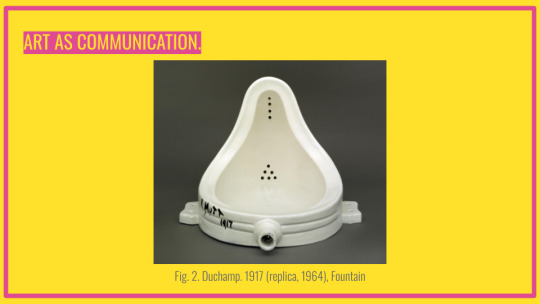
Art has been used as a form of communication ever since people have been making art. It can transcend current language barriers by virtue of shared cultural ideas and representational imagery, especially in the modern day where we have more access to shared culture and art than ever. Art is hard to define, and there still isn’t a consensus on what it is, however, as journalist Daniel Oberhaus notes, many people know it when they see it. He also notes that cultural context plays an important role in the understanding of art; a urinal is not art, unless it is displayed in a gallery. In The Philosophical Disenfranchisement of Art, Arthur Danto explicitly states that it was a urinal, until it became a work of art- the cultural knowledge of an art gallery changes the meaning of the piece. Niklas Luhmann in his essay The Medium of Art explores the idea that works of art exist to communicate meaning before anything else; that they are produced of a medium, and then become a medium themselves, one of communication. So what do we do, then, when neither consistency of language nor culture is guaranteed? What do we do when art must communicate messages to people so far in the future we cannot make any assumptions about the preconceptions a viewer will bring, or the culture in which they operate? What do we do when the message we have to bring to them is extremely important, and does not leave room for misinterpretation?
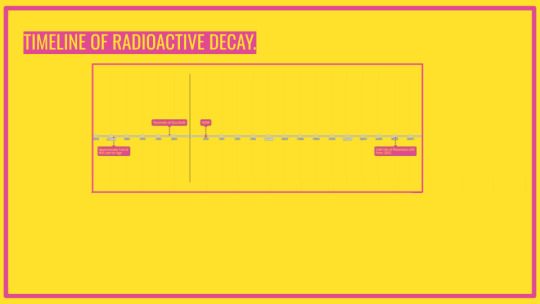
One message that is incredibly important for humans now to send is marking our long term deep geological nuclear waste repositories as dangerous and the areas above them as uninhabitable. However, working with nuclear isotopes, and their long half-lives, confronts us with the aforementioned questions; the message is extremely important, cannot be misinterpreted, and we can safely assume any viewer will share no language or culture with us today.
Most storage involves transuranic elements- that is, isotopes heavier than uranium- used for both creation of nuclear arms, and nuclear power stations, with two of the most common contaminants being Plutonium-329 and Uranium-235. This is the half-life of Plutonium-329.
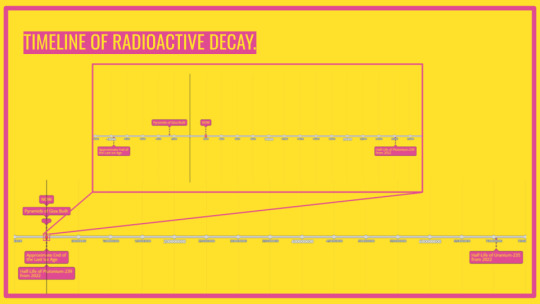
And this is the half-life of Uranium-235.
And this is the time scale on which people have had to think to design warnings for the Waste Isolation Pilot Plant, in New Mexico, USA- licensed to store waste from nuclear arms development which opened for operation in 1999, and is due to be backfilled between 2025 and 2035.
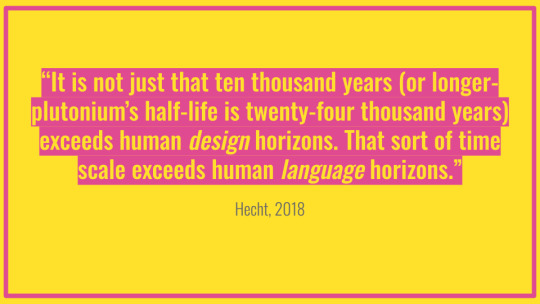
Gabrielle Hecht said of the issue in 2018, “It is not just that ten thousand years exceeds human design horizons. That sort of time scale exceeds human language horizons.”
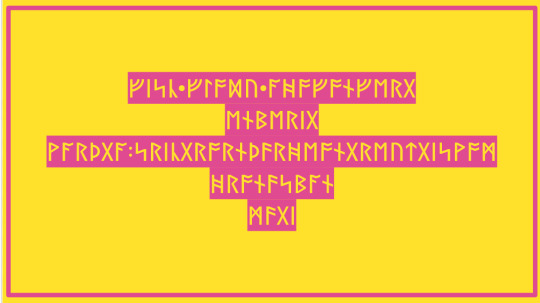
To put a bit of context to these unthinkably large numbers and the issue with communicating over time spans on this scale, this is a fragment of Old English from the Franks Casket, written in Anglo-Saxon runes. This is estimated to have been written only 1,300 years ago. It is unintelligible to English speakers today.
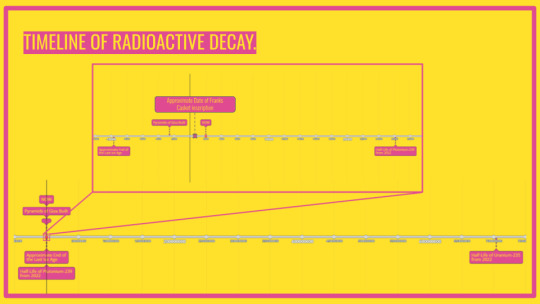
And to put that onto the timeline, we can see the distance in time between the Franks Casket and now is tiny compared to how long the warnings need to last. In his letter declining the invitation to join the Sandia National Laboratories report on nuclear waste markers, Carl Sagan described the problem as such:
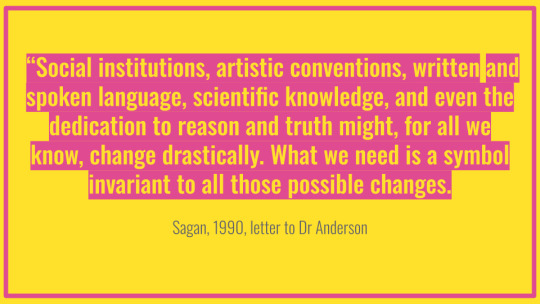
“... artistic conventions, written and spoken language… might, for all we know, change drastically. What we need is a symbol invariant to all those possible changes. Moreover, we want a symbol that will be understandable not just to the most educated and scientifically literate members of the population but to anyone who might come upon this repository.”
Sagan brings up a very important point: the need for any symbol to be universally understood, regardless of the viewer's education, age, or cultural background. This, I think, is the largest obstacle we face, given that we didn’t even have this problem solved until 2007, despite having infinite access to research the people that live now.
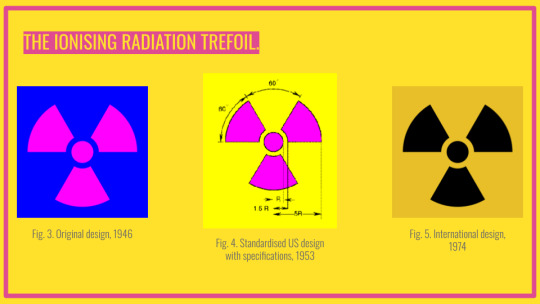
In 2001 the International Atomic Energy Agency and International Organisation for Standardisation were faced with the challenge of making a new symbol to denote immediate severe radiation hazard after a 2000 incident, where three people in Samut Prakan province, in Thailand, died from radiation exposure after coming across a cobalt-60 source, previously used for cancer radiotherapy, in a scrap yard. The source was secured properly (although not disposed of properly), and displayed the proper warning symbols, but it made no difference, because the people didn’t recognise the symbol, and none of the written warnings were in Thai.
The original warning design was conceived at the University of California Berkeley Radiation Laboratory in 1946, by a group of people who were doodling out designs that could be used to symbolically represent radiation hazards. Nels Garden, one of the scientists involved in the designing process, gave insight into the design in letters sent after the event. The design was supposed to represent an atom emitting radiation. The first design was this one, with the magenta trefoil on the blue background. Magenta was chosen because it didn’t conflict with any existing colour coding rules, and the ink was expensive, which they hoped would ensure people did not use the symbol frivolously and reduce its impact as a warning. The blue was chosen because there were no other blue warnings and labels used in radioactive work of the time, meaning it was distinctive, however it received criticism for being low visibility, as well as the fact that blue was not supposed to be used on warning signs, as it fades quickly.

In 1948 yellow was standardised for the sign at the Oakridge National Lab, following requests for a standardised colour scheme, after a committee viewed the magenta symbol stapled to different coloured cardboard, and deemed magenta and yellow the best combination. Until its final standardisation by the American National Standards Institute in the 1950s, there were a few variations of the symbol. In 1974 the ISO approved a design for international use, in which the trefoil is black instead of magenta.
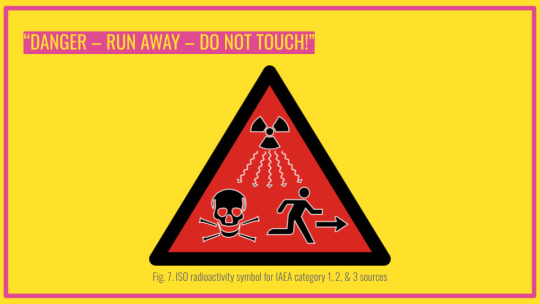
And, in a town in Thailand, none of that mattered. Faced with foreign language warnings and a symbol none of the scrapyard workers recognised, the immediate danger they were in was not adequately communicated by the trefoil. The 2001 assignment, the New Warning Symbols Project, needed a symbol that would unfailingly communicate “danger, run away, do not touch.” In 2007 they presented the high level sealed-source ionising radiation symbol. In target groups of children of many nationalities, the trefoil symbol meant something like a propeller or a windmill, and the colour yellow did not indicate the immediate life threatening danger. In many more tests conducted around the globe, they settled on the current design as being the one that most clearly portrayed the message without words. Of all the symbols tested, skull and crossbones was the only one that consistently conveyed the meaning of “this may harm you so much that you will die.” The yellow was replaced with red to move the warning from “caution” to “active danger” in the eyes of viewers.
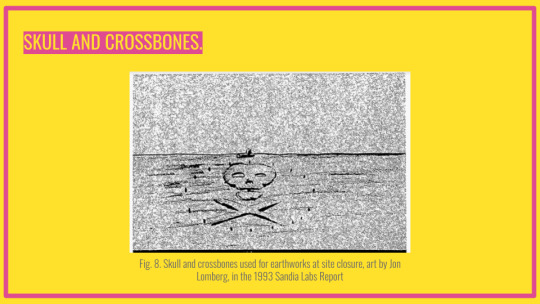
The result of the research echoes what Sagan wrote in his letter to Sandia Labs, recommending skull and crossbones as symbols to be placed around the WIPP, which he said has “unmistakable” meaning, referring to pirate flags, bottles of poison, and Nazi divisions- all things which are bad and to be avoided; although the report itself points out that in Mexico bones are considered to hold life force, so alternative messages would also be required, especially considering the WIPPs proximity to the US-Mexico border, and Oberhaus points out that it only emerged as a symbol of toxicity relatively recently, that is- recently on the scale of radioactive isotopes, with no guarantee it will last.

The first published attempt to solve the problem of producing a universally understood message that is as clear in 100 years as it is in 10,000, though posed as a thought experiment rather than as part of government action like the at the time recently formed Human Interference Task Force, was the 1982/1983 poll in the Berlin Institute of Technology’s Journal of Semiotics, which asked “How do we tell our children’s children where the nuclear waste is?”
The suggestions with the least amount of subsequent research (or, at least, subsequent research in English) are, with one exception, the most conceptually mundane, so I will only give an overview of the exciting one. Polish science fiction writer Stanislaw Lem suggested satellites that endlessly transmit the messages back to Earth. He also proposed encoding messages into the DNA of plants that he dubbed Atomic Flowers which would replicate and renew into forever. He suggested that the plants be only grown in the vicinity of the repositories, and contain information about the danger of the camp. The major issue with this, pointed out by Lem himself, was who would ever even think to decode DNA for a hidden message? And if the message was known about would they consider the decoding an endeavour worth pursuing.
Two of the suggestions connected to this poll are more fleshed out, the Ray Cat Solution and the Atomic Priesthood.

The Ray Cats solution is my personal favourite, in theory. In reality it's wholly problematic, for ethical reasons.
Ray Cats proposes genetically engineering cats to change colour in the presence of radiation, and the message will be passed down and preserved via fairy tales, poems, and nursery rhymes- which are typically long lived and cross-culturally intelligible. It hopes to build off the superstition surrounding black cats- either bad luck or good luck depending on where you are, and your cultural background.
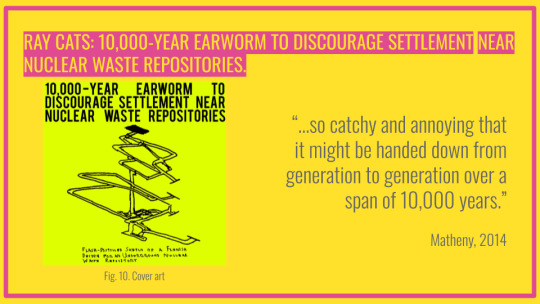
One such cultural marker was a song written 2014 by physicist turned musician Chad Matheny, also known as Emperor X, who described the brief as to create a song “so catchy and annoying it might be handed down… over a span of 10,000 years.” It was titled “10,000-Year Earworm to Discourage Settlement Near Nuclear Waste Repositories”
Beyond the song, there isn’t much art here. There’s a lot of science, and a lot of ethics, but little has been considered artistically.
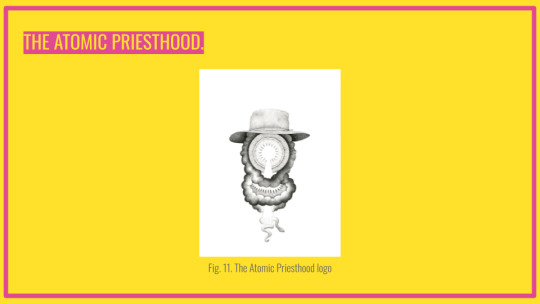
The concept from this poll which has been expanded upon the most is the Atomic Priesthood, suggested by linguist Thomas Sebeok, and it is currently being developed by the Atomic Priesthood Project- a collective of artists working towards preserving the messages of the dangers of nuclear waste and their locations. The Atomic Priesthood is built from the principle that the Catholic Church has survived with a pretty consistent message for 2000 years, and had to convene groups to enact significant change in their doctrine. For example, they would create rituals and myths surrounding the consequences of disturbing the waste. They would dictate which areas are forbidden, and dictate what retribution awaits those who disobey, literal or metaphysical. Issues with this idea arose almost immediately, for example schisms akin to the Protestant Reformation distorting the message, and what happens if Nuclear Atheists emerge, denying the existence of the danger?
Despite the issues, a lot of lore, doctrine, and rite has been established for the Atomic Priesthood. They have worked in collaboration with many artists across many disciplines, including Dana Sherwood, Helen Lee, Duy Hoang, Claire Beaumont and many more.
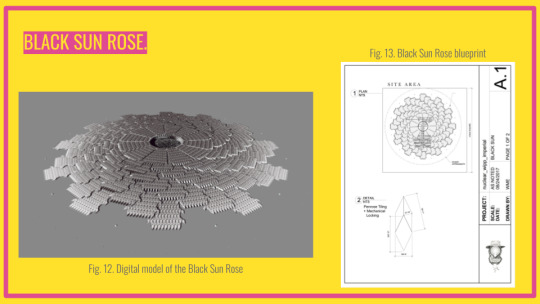
One of their projects, beginning in 2017, was to develop nuclear warning monoliths. They used the WIPP as a base, and followed the guidelines set out in the 1993 Sandia Labs report on Expert Markers to Deter Inadvertent Human Intrusion into the Waste Isolation Pilot Plant, and came up with the Black Sun Rose. They are interlocking monoliths, following a Penrose pattern - meaning they can be tiled infinitely outwards. The blocks are to be cast from black dyed concrete; concrete being readily available and extremely long lasting, and dyed black to discourage animal and human habitation on the site, due to its absorption of New Mexico desert heat. The structure must be at least 4 square miles, large enough to fully cover the underground footprint of the site. At this size, it will also be visible from space.

They will also use glass for the embedding of written messages. Glass will be used as it is the most geologically stable and chemically inert material that can be mass produced. The messages will be produced by embedding coloured rods in clear glass, making a sort of 3 dimensional font, based on the work ‘Alphabit’ by Helen Lee. The letters can then be fused into one large wall, with the rods being slightly curved to bounce sunlight through the rods, using the same principle as fibre optic cables. This will cause the walls of text to illuminate. The properties of the glass mean that any writing system or image that can be embedded in this way will not be obscured or removed by damage. This seemingly solves the issue that arises with stone carvings, where chipping of stone can make the message unintelligible.

The rose structure will be perimetered by kiosks, containing the glass panels, and they will warn people to leave, and of the danger, in various languages and through pictograms. There will also be “deep dolmen” and these will be created of the same penrose blocks as the rest of the structure, and be entirely enclosed, with no way of access except removing one of the large blocks- a daunting, but not impossible task, depending on the technological level of the people who find them. The hope is that uncovering something, anything through means of brute force and excavation will be enough of a satisfying result for intruders that the actual danger remains undisturbed. The information stored in these will be much more in depth than what is displayed in the kiosks, but also redundant, such that if they are never opened, the message of the whole site remains intelligible and complete.
As of 2020, these designs are just a proposal.
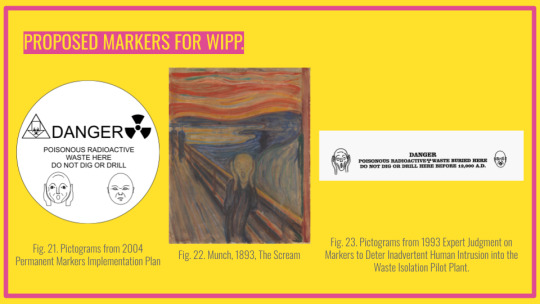
The largest body of research and design concepts comes from the aforementioned 1993 Expert Judgment on Markers to Deter Inadvertent Human Intrusion into the Waste Isolation Pilot Plant produced by Sandia National Laboratory for the United States Department of Energy.
One of the things it covers is the use of pictograms. Working under the assumption that any language spoken today will be gone, they decided that using pictograms along with written warnings would stop the warning signs from becoming entirely obsolete after the extinction of current languages.
The pictograms are more faces and less abstract representations. Usage of Munch’s The Scream was done to portray “abject horror and terror”, and the report concludes that usage of faces is most suitable for cross-cultural intelligibility, as the expressions associated with fear, apprehension, and disgust, are universal. A 2009 study by Matsumo and Willingham analysed the spontaneous expressions produced by congenitally blind, non-congenitally blind, and sighted athletes, and found that there was little difference between the facial emotion configuration between the groups, and no difference at all cross-culturally. So using faces is likely a good call, because unless humans are wiped out and replaced by something else, there shouldn’t be much major change in cultural understanding of expressions, as at least something about them appears to be innate.
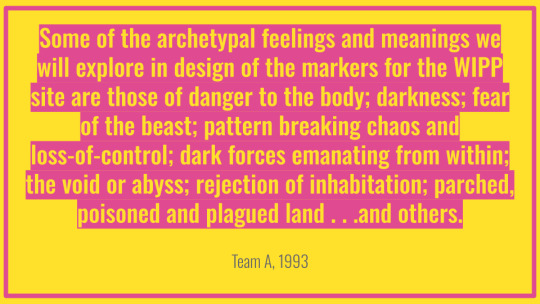
They also considered large structural designs that would go on to inspire the Atomic Priesthood’s Black Sun Rose. As well as emphasising the fact that the structures need to only deny land habitation and produce deep emotional response in the viewer, the report described the designs as provoking feelings of “danger to the body”, “fear of the beast”, “dark forces emanating” and “abyss.”
A 2012 study showed that shapes with sharp abrupt angles are associated with emotions with abrupt onset, such as surprise and anger, and a 2021 study showed, using 3d objects instead of 2d drawings, spiked objects being associated with unpleasant, uncontrolled and high arousal emotions, and we can see this from the designs presented in the report, although no specific research of the kind is mentioned.
The structures are separated into two groups:
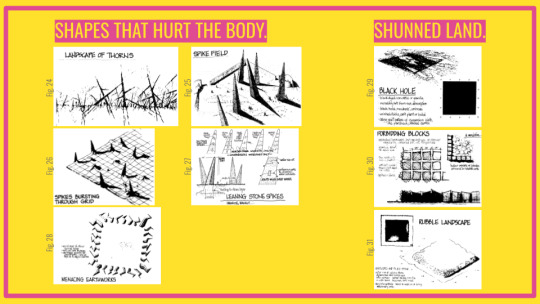
Shapes that hurt the body, and shunned land.
The report describes them as such:
Danger seems to emanate from below. The shapes suggest wounding forms, like thorns and spikes, even lightning. They seem active, in motion cut and up, moving in various directions. They seem not controlled. Walking through it, at ground level, the massive earthworks crowd in on you, dwarfing you, cutting off your sight to the horizon, a loss of connection to any sense of place.
And:
An image of an enormous black hole; an immense nothing; a void; land removed from use with nothing left behind; a useless place. It is a massive effort to make a place that is fearful, ugly, and uncomfortable.
An anomaly both topographic and in roughness of material. An enormous landscape of large-stone rubble, one that is very inhospitable, being hard to walk on and difficult to bring machinery onto. It is a place that feels destroyed, rather than one that has been made. They are deliberately irregular and distorted cubes. The cubic blocks are set in a grid, defining a square, with 5-foot wide’’streets” running both ways. You can get “in” it, but the streets lead nowhere, and they are too narrow to live in, farm in, or even meet in. It is a massive effort to deny use. It is an ordered place, but crude in form, forbidding, and uncomfortable.
None of our designs use any of the regular or “ideal” geometric forms. Why? The geometry of ideal forms, like squares and cubes, circles and spheres, triangles and pyramids is a fundamental human invention, a seeking of perfection in an imperfect world. Historically, people have used these ideal forms in places that embody their aspirations and ideals. In our designs, there is much irregularity both of forms and in their locations and directions, yet done by people with obvious knowledge of pure geometry. This shows an understanding of the ideal, but at the same time a deliberate shunning of it... suggesting we do not value this place, that it is not one that embodies our ideals.
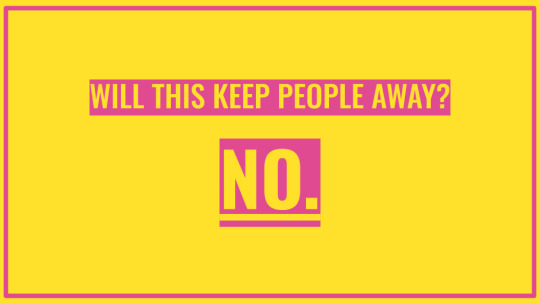
And will any of this work?
No. At least in my opinion.
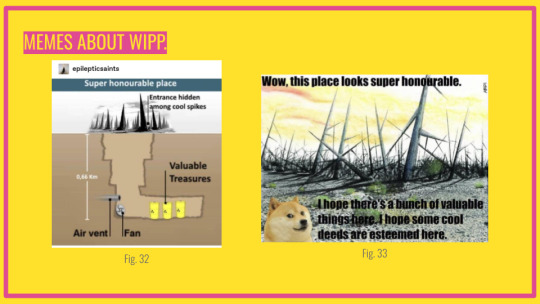
Already the WIPP and its warning messages and structures have become memes; framing the forbidding spires as cool formations that must be there to protect the valuable treasure below.
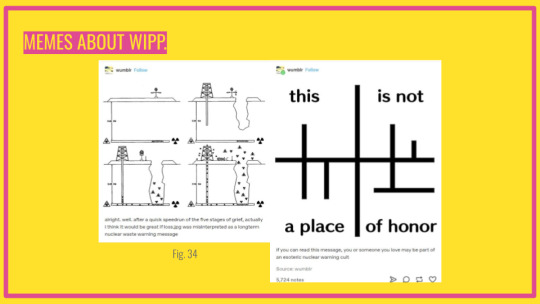
A tumblr user compares an image from the Sandia National Labs report to the meme Loss.jpeg, and jokes that Loss will be interpreted in the future as a nuclear waste warning. And it’s funny, I think it is a funny bit, but underlying a lot of the jokes about these markers is a resignation that we already know none of this will prevent intrusion into the sites.
Physicist Woodruff Sullivan points out in the report that it’s largely a self correcting problem anyway. Nothing is as good a deterrent for disturbing nuclear waste as the consequences of disturbing nuclear waste; but that view requires people to potentially die over and over as each new generation finds the site.
But on the prospect of a more artistic warning, Jon Lomberg succinctly states that:
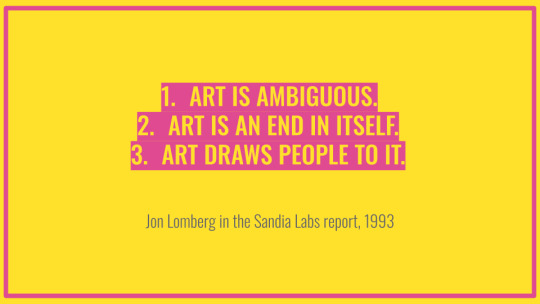
One. Art is ambiguous
Two. Art is an end in itself.
Three. Art draws people to it.
And I am tempted to agree with him.

As “One can hardly imagine a more titillating prospect for archaeologists of the future.”
youtube
And here is the 10,000 year earworm.
List of Figures:
Figure 1. International Atomic Energy Agency (2014) The Radiological Accident in Lia, Georgia. Vienna: International Atomic Energy Agency. pp. 14
Figure 2. Duchamp, M. 1917, replica 1964. Fountain. [Readymade] At: London: Tate Modern. T07573
Figures 3, 5 & 7. Chung, N. (2018) Radiation Symbol (1948) Available at: https://medium.com/fgd1-the-archive/radiation-symbol-1948-fcc2ddc33ff0
Figure 4. Origin of the Radiation Warning Symbol (Trefoil) (no date) Available at: https://www.orau.org/health-physics-museum/articles/radiation-warning-symbol.html
Figure 6. Prototype Trefoil Warning Sign with Yellow Background (1948) (no date). Available at: https://www.orau.org/health-physics-museum/collection/warning-signs/prototype.html
Figure 8. Trauth, K.M., Hora, S.C. and Guzowski, R.V. (1993) ‘Expert judgment on markers to deter inadvertent human intrusion into the Waste Isolation Pilot Plant’, Office of Scientific & Technical Information Technical Reports. pp. G-13
Figure 9. Hargreaves, A. 2022. Literally just a photograph of my cat, Luna. [Photograph]
Figure 10. Matheny, C. (2014) 10,000-Year Earworm to Discourage Settlement Near Nuclear Waste Repositories. Available at: https://emperorx.bandcamp.com/album/10000-year-earworm-to-discourage-settlement-near-nuclear-waste-repositories
Figures 11-13, & 15-20, Black Sun Rose (WIPP) (2017). Available at: http://www.theatomicpriesthoodproject.org/artists#/black-sun-rose-wipp
Figure 14. Lee, H. 2018. Alphabit. [Glass murrine, stainless steel, aluminum, acrylic, LEDs] Available at: https://pink-noise.org/portfolio/alphabit/
Figure 21. United States Department of Energy (2004) Permanent Markers Implementation Plan. Carlsbad: Washington Regulatory and Environmental Services an affiliate of Washington TRU Solutions, LLC. pp. 23
Figure 22. Munch, E. 1893. The Scream. [Oil, tempera, pastel, and crayon] At: Oslo: Nasjonalgalleriet. NG.M.00939
Figure 23. Trauth, K.M., Hora, S.C. and Guzowski, R.V. (1993) Expert judgment on markers to deter inadvertent human intrusion into the Waste Isolation Pilot Plant. Albuquerque: Sandia National Laboratories. pp. F-115
Figures 24-31. Trauth, K.M., Hora, S.C. and Guzowski, R.V. (1993) Expert judgment on markers to deter inadvertent human intrusion into the Waste Isolation Pilot Plant. Albuquerque: Sandia National Laboratories. pp. F-61-F-75
Figure 32. Love How This Implies That After The Downfall Of Humankind That Doge Is The Species To Supercede Us. (2020) Available at: https://parakavka.tumblr.com/post/635856004706418688/
Figure 33. #super honourable place. (2022) Available at: https://epilepticsaints.tumblr.com/post/696755723763367936
Figure 34. alright. well. (2021) https://wumblr.tumblr.com/post/646314177178255360/wumblr-alright-well-after-a-quick-speedrun-of
Bibliography:
Atomsemiotik (no date). Available at: https://www.chemie.de/lexikon/Atomsemiotik.html
Barrett, R. and Stephens, L. D. (1978) A Brief History of a “20th Century Danger Sign.” Berkeley: Lawrence Berkeley National Laboratory. Available at: https://escholarship.org/uc/item/7cz9p0m6#main
Benford, G. (2001) Deep Time: How Humanity Communicates Across Millennia. New York City: Avon Books
Dahlstrom, D. (2007) ‘New Symbol Launched to Warn Public About Radiation Dangers’, International Atomic Energy Agency. Available at: https://www.iaea.org/newscenter/news/new-symbol-launched-warn-public-about-radiation-dangers
Fakultät I Geisteswissenschaften: Bd_6_Hft_3 (no date). Available at: https://www.semiotik.tu-berlin.de/menue/zeitschrift_fuer_semiotik/zs-hefte/bd_6_hft_3/
Griffenhagen, G. and Bogard, M. (1999) History of Drug Containers and Their Labels. Madison: American Institute of the History of Pharmacy.
Hecht, G. (2018) ‘Interscalar Vehicles for an African Anthropocene: On Waste, Temporality, and Violence’, Cultural Anthropology 33, no. 1
Human Interference Task Force (1984) Reducing the Likelihood of Future Human Activities That Could Affect Geologic High-level Waste Repositories. Technical Report. Columbus: Office of Nuclear Waste Isolation. Available at: https://www.osti.gov/servlets/purl/6799619
Ialenti, V. (2020) Deep Time Reckoning: How Future Thinking Can Help Earth Now. Cambridge: The MIT Press.
International Atomic Energy Agency (2002) The Radiological Accident in Samut Prakarn. Vienna: International Atomic Energy Agency. Available at: https://www-pub.iaea.org/mtcd/publications/pdf/pub1124_scr.pdf
International Atomic Energy Agency (2014) The Radiological Accident in Lia, Georgia. Vienna: International Atomic Energy Agency. Available at: https://www-pub.iaea.org/MTCD/Publications/PDF/Pub1660web-81061875.pdf
Jess and Zak (2016) “The Puzzling Meaning and Origin of the Radiation Sign,” University of California Research blog. Available at: https://ucresearch.tumblr.com/post/148796081116/the-puzzling-meaning-and-origin-of-the-radiation
Kawahara, S., and Shinohara, K. (2012). A tripartite trans-modal relationship among sounds, shapes and emotions: A case of abrupt modulation. Proceedings of the Annual Meeting of the Cognitive Science Society, 34, pp. 569-574. Available at: https://escholarship.org/uc/item/47b452vw
Lin, A. et al. (2021) “Feeling Colours: Crossmodal Correspondences Between Tangible 3D Objects, Colours and Emotions,” Proceedings of the 2021 CHI Conference on Human Factors in Computing Systems. Available at: https://doi.org/10.1145/3411764.3445373
Lodding, L. (2007) ‘Drop It and Run! New Symbol Warns of Radiation Dangers and Aims to Save Lives’, International Atomic Energy Agency Bulletin, 48(2), pp. 70-72. Available at: https://www.iaea.org/sites/default/files/publications/magazines/bulletin/bull48-2/48202087072.pdf
Macfarlane, R. (2019) Underland: A Deep Time Journey. London: Penguin Books
MacKenzie, C. (2006) ‘Reducing the Risk from Radioactive Sources’ International Atomic Energy Agency Bulletin, 47(2), pp. 61-63. Available at: https://www.iaea.org/sites/default/files/publications/magazines/bulletin/bull47-2/47202006163.pdf
Matheny, C. (2014) 10,000-Year Earworm to Discourage Settlement Near Nuclear Waste Repositories. Available at: https://emperorx.bandcamp.com/album/10000-year-earworm-to-discourage-settlement-near-nuclear-waste-repositories
Matsumoto, D. and Willingham, B. (2009) “Spontaneous facial expressions of emotion of congenitally and noncongenitally blind individuals.,” Journal of Personality and Social Psychology, 96(1), pp. 1–10. Available at: https://doi.org/10.1037/a0014037
Oberhaus, D. (2019) Extraterrestrial Languages. Cambridge: The MIT Press.
Origin of the Radiation Warning Symbol (Trefoil) (no date). Available at: https://www.orau.org/health-physics-museum/articles/radiation-warning-symbol.html
The Franks Casket/The Auzon Casket. ca. 700. [Whalebone] At: London: British Museum, Britain, Europe and Prehistory. 1867,0120.1
Trauth, K.M., Hora, S.C. and Guzowski, R.V. (1993) Expert judgment on markers to deter inadvertent human intrusion into the Waste Isolation Pilot Plant. Albuquerque: Sandia National Laboratories. Available at: https://doi.org/10.2172/10117359
United States Department of Energy (2004) Permanent Markers Implementation Plan. Carlsbad: Washington Regulatory and Environmental Services an affiliate of Washington TRU Solutions, LLC. Available at: https://www.wipp.energy.gov/library/permanentmarkersimplementationplan.pdf
United States Department of Energy (2018) Site Markers. Available at: https://wipp.energy.gov/pdfs/site_markers.pdf
14 notes
·
View notes
Text
rip Niklas Luhmann you would have loved tumble web weaving
7 notes
·
View notes
Text
Während einer Taxifahrt von irgendeinem Flughafen, versuchte Kittler Luhmann zu erklären, dass im Gegensatz zu sozialen Systemen digitale Schaltkreise ohne Input und Output nicht existieren können. »Herr Kittler«, antwortete Luhmann, »so war es schon in Babylon. Ein Bote reitet durchs Tor. Die einen (wie Sie) fragen, welches Pferd er reitet; die anderen (wie ich), welche Botschaft er bringt.«
Friedrich Kittler, Unsterbliche. Nachrufe, Erinnerungen, Geistergespräche, München 2004, S. 97.
2 notes
·
View notes
Note
out of curiosity, what is telegraphy of communication?
Telegraphic thinking condenses amodal, propositional information; it is complex semantic clustering. This makes it ideal for rapidly wielding (findings from) sizeable topics while remaining durable enough for reuse amongst other telegraphic statements. Long-term telegraphy would also stimulate some idiolect, either repurposing existing phrases with new definitions or using haptic phrasing to "pull" semantic value closer to the "surface" of the text. But does telegraphy actually provide mass communicative value? Thought and communication may fuse and feedback into each other at the level of language, but they cannot be wholly interchanged nor should they be. Academics do not make their work as short as possible; they make it as organized as possible. Telegraphy is most effective as a transient functional response.
---
Telegraphy of information is basically being as direct and terse with your wording as possible while keeping max information. It's a bit more rich than summarization — all the chatbots can summarize, ad nauseum. This is closer to Ernest Hemingway, thesis sentences, specific distributivity, etc. You condense your thinking, and triage what you actually care about for your intended recipient (e.g. another person, a piece of writing, your future self). I don't have it down perfectly, but I'm trying. The former shouldn't be a mandate for telegraphic writing; we all speak and write differently, so it holds that every person has a slightly different telegraphic style. I prefer to compound adjectives. Maybe someone else likes sticking individual nouns together; or they simply away with propositions, conjunctions, and other function words.
From Cevolini and Schmidt 2016, "Forgetting Machines: Knowledge Management Evolution in Early Modern Europe":
Whereas the early notes [in Niklas Luhmann's entire oeuvre of notes, from his time as a senior civil servant all the way to an academic and professor of sociology] from the 1950s and 1960s frequently tended to be more of the running-text kind and more closely reflected the original readings, they increasingly became more compact and thesis-like in the 1970s. Particularly, these later notes were not simply excerpts [...] for instance, the [bibliographic] notes from reading an entire book frequently fit onto one of these cards [A-6 European format].
And from one of his cards in the ongoing digitization project, translated:
536/2c18a Important consequences for the process of institutionalization: There is a lack of time to explicitly protest against everything implied. As a result, one becomes entangled in shared assumptions.
I think my last sentence sums up my stance on telegraphic writing well: it's not always sustainable or appropriate, and that's fine. If you wrote and spoke like that all the time, it'll impede your communication. Luhmann's publications were and still are notoriously difficult to translate into English, because he couldn't quite get out of this slipbox/condensing mentality. (Apparently his transcribed lectures are easier to follow.) You compare him to someone like Bob Doto who has been a writer long before he picked up the zettelkasten system: his book, "A System for Writing" is written as if he organized and drafted it like it were a regular book (because it is). Telegraphic phrasing serves an internal function to propagate and stimulate further thinking, but it doesn't (necessarily) constitute the blogpost you'll be posting to Tumblr or Substack.
#personal knowledge management#zettelkasten#morning mail#sorry for the late response! scheduling this for the morning...#telegraphic thinking
2 notes
·
View notes